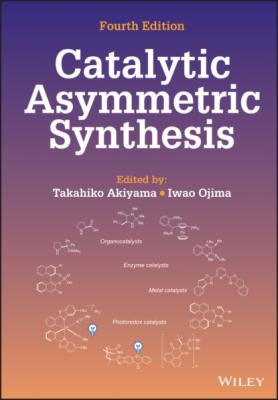Catalytic Asymmetric Synthesis. Группа авторов
Чтение книги онлайн.
Читать онлайн книгу Catalytic Asymmetric Synthesis - Группа авторов страница 62
 href="#ulink_f8ea5ce3-79fa-5f3b-86fa-904ba8d80040">Scheme 3.24. Enantioselective Michael/cyclization reaction sequence catalyzed by 2v. Source: Based on [47].
href="#ulink_f8ea5ce3-79fa-5f3b-86fa-904ba8d80040">Scheme 3.24. Enantioselective Michael/cyclization reaction sequence catalyzed by 2v. Source: Based on [47].
On the other hand, Connon and Manoni reported the catalytic enantioselective Tamura cyclization of enolizable anhydrides with alkylidene oxindoles, providing a different type of spirooxindoles (Scheme 3.25) [48]. In this reaction, an unusual temperature‐controlled diastereodivergency was observed.
Scheme 3.25. Enantioselective Tamura cyclization catalyzed by 2w.
Source: Based on [48].
The enantioselective formal [3+2] cycloaddition of cyclopropyl ketones with nitroalkenes was developed by Jørgensen and co‐workers (Scheme 3.26) [49]. This reaction would involve the ring‐opening of a cyclopropane moiety, which would occur through the deprotonation of the α‐proton and β‐elimination under the influence of amine‐thiourea catalyst 2x, and the following stereoselective intermolecular/intramolecular addition sequence.
Scheme 3.26. Enantioselective formal [3+2] cycloaddition of cyclopropyl ketones with nitroalkenes catalyzed by 2x.
Source: Based on [49].
Rodriguez, Coquerel, and co‐workers established the enantioselective synthesis of benzazocinones by using cinchona alkaloid‐squaramide catalyst 2c [50]. The reaction involves the Michael addition/four‐atom ring expansion cascade from activated cyclobutanones and ortho‐amino nitro styrene derivatives (Scheme 3.27). The resulting benzazocinone products could be further converted into functionalized glutarimide derivatives by 1,8‐diazabicyclo[5.4.0]undec‐7‐ene (DBU) catalyzed ring contraction.
Scheme 3.27. Enantioselective synthesis of benzazocinones. Source: Based on [50].
As a different type of application of the catalysis, Bressy, Bugant, Rodriguez, and co‐workers developed an enantioselective synthesis of axially chiral 4‐arylpyridine derivatives 19 based on the central‐to‐axial chirality conversion strategy (Scheme 3.28) [51]. In this synthesis, 4‐aryl‐1,4‐dihydropyridines 18 having a central chirality were first prepared through the enantioselective Michael addition of dimedone to chalcone derivatives catalyzed by Takemoto’s catalyst 2a and the treatment of the resulting Michael adducts with ammonium acetate. Then, the intermediates 18 were converted to the corresponding axially chiral 4‐arylpyridines 19 by MnO2‐mediated oxidation with moderate to high conversion percentage (cp = %ee of substrate/%ee of product).
Scheme 3.28. Enantioselective synthesis of axially chiral 4‐arylpyridine derivatives based on the central‐to‐axial chirality conversion strategy.
Source: Based on [51].
Later, the same group achieved, for the first time, the synthesis of enantio‐enriched atropoisomeric furans based on the central‐to‐axial chirality conversion strategy (Scheme 3.29) [52].
Scheme 3.29. Enantioselective synthesis of atropoisomeric furans based on the central‐to‐axial chirality conversion strategy.
Source: Based on [52].
Yan and co‐workers developed the intramolecular [4+2] cycloaddition between in situ generated vinylidene ortho‐quinone methides 20 and benzofurans (Scheme 3.30) [53]. In the reaction processes, cinchona alkaloid‐thiourea catalyst 2t promoted the enantioselective prototropic rearrangement (tautomerization) of a 2‐alkynyl naphthol to generate axially chiral vinylidene ortho‐quinone methide 20. Subsequently, the formal inverse electron‐demand hetero‐Diels‐Alder reaction of the vinylidene ortho‐quinone methide with a benzofuran, driven by both rearomatization and strain release, occurred to provide the cycloaddition product. The same group later achieved the enantioselective construction of axially chiral styrenes based on the strategy utilizing the catalytic generation of axially chiral vinylidene ortho‐quinone methides by using chiral acid–base bifunctional catalysts [54].
Scheme 3.30. Intramolecular [4+2] cycloaddition between in situ generated vinylidene ortho‐quinone methides and benzofurans.
Source: Based on [53].
3.3. CHIRAL GUANIDINE CATALYSTS
Guanidine is present in a variety of natural products and plays a key role in many biological activities. It can also be found as the side chain of arginine, one of natural amino acids. The intrinsic and distinctive property of guanidine is its strong basicity resulting from the resonance stability in its conjugate acid form, namely guanidinium cation, in which the positive charge can be delocalized over the three nitrogen atoms. In addition, guanidinium cation can interact strongly with anionic species through the combination of hydrogen bonding and ionic bonding, which is widely utilized in molecular recognition [55]. Because of such characteristic features of guanidine and guanidinium cation, chiral guanidine has attracted considerable attention as a promising platform for chiral Brønsted base catalysts in the field of asymmetric synthesis. Indeed, a variety of chiral guanidine catalysts has been developed, and, as a result, various types of useful enantioselective transformations including carbon–carbon bond formations and carbon‐heteroatom bond formations have been accomplished over the past two decades, which are comprehensively summarized in the literature based on the types of transformations or those of catalysts [4]. Following are the representative chiral guanidine